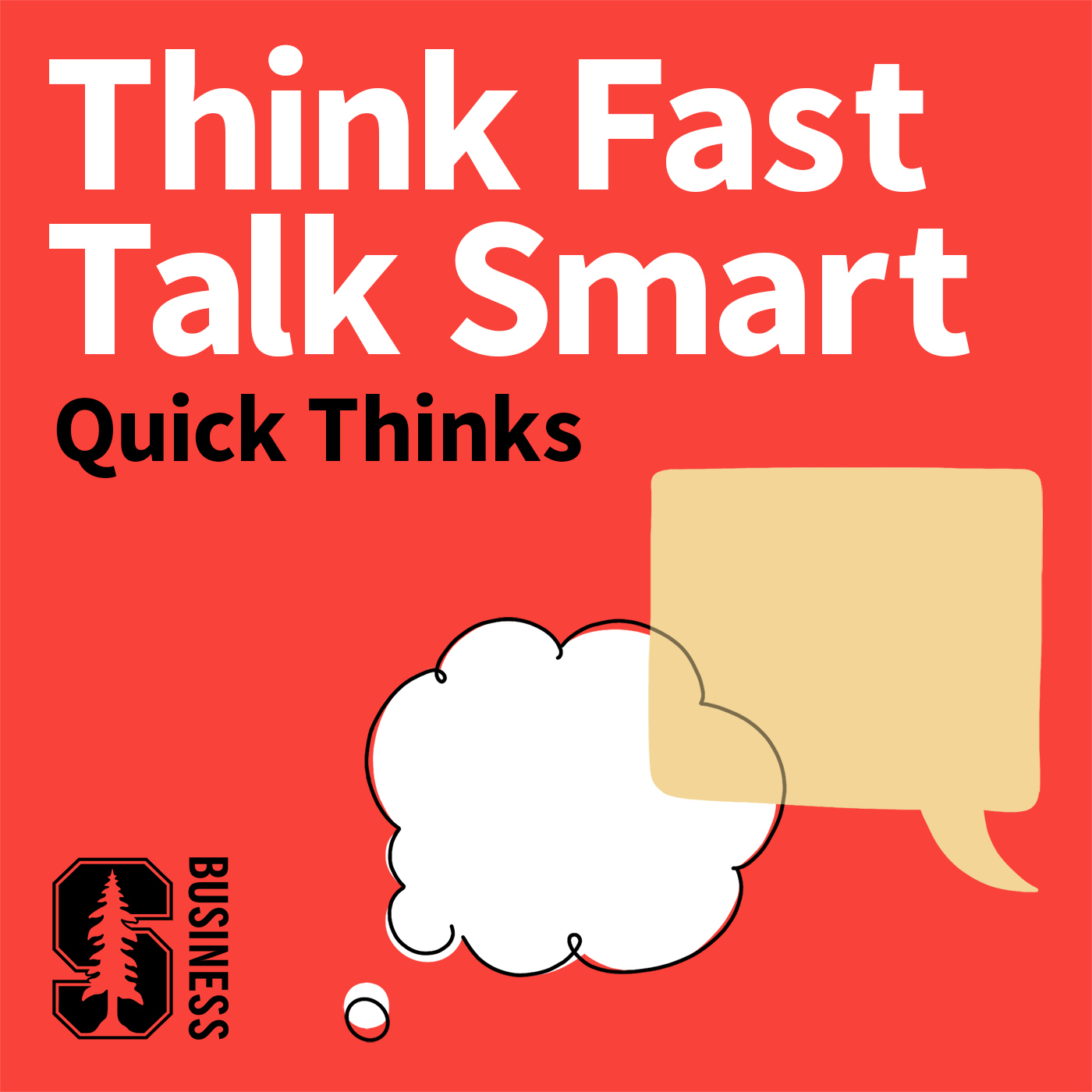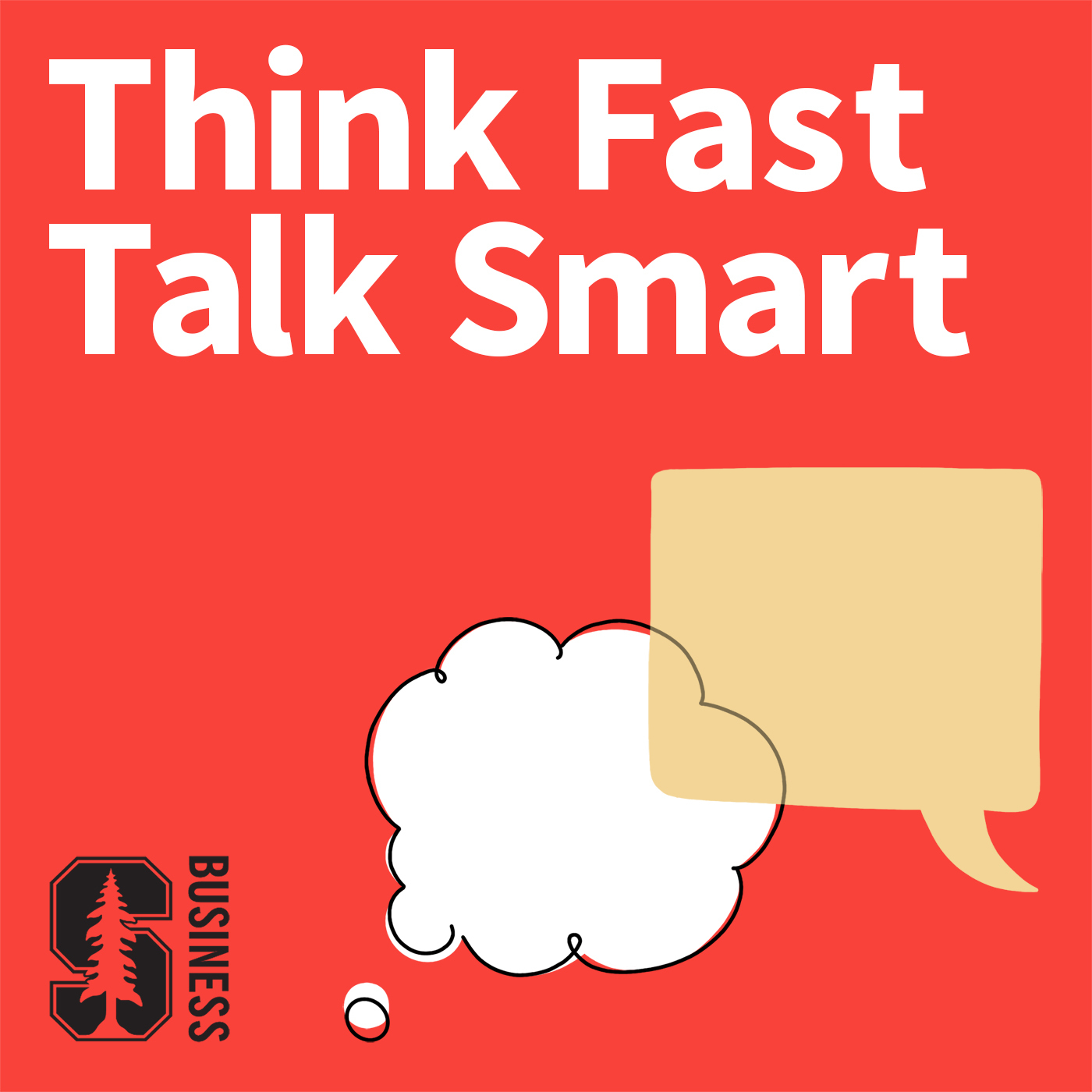
31. Quick Thinks: How to Shine Online and Excel at Virtual Communication

Think Fast, Talk Smart: Communication Techniques
Deep Dive
Shownotes Transcript
Hi, Matt here. I invite you to look into Stanford Continuing Studies. For over 20 years, I have taught in the program. Discover a diverse range of courses available both online and in person to anyone, anywhere in the world. Classes cover everything from fundamental business skills to the fascinating world of AI. This fall, join me for Communication Essentials for Work and Life, a new course designed to enhance and hone your communication skills in various situations.
Each week, guest speakers will join me for interactive lectures and Q&A sessions on topics like persuasion, storytelling, nonverbal presence, and reputation management. The course starts September 24th, and registration is now open. Learn more at continuingstudies.stanford.edu.
All of us are moving towards more virtual communication. That is a shift in context. That's going to change the way people understand you, the way people experience you. You cannot engage in exactly the same behavior and assume that you're going to get exactly the same results if the context shifts. It's been more than a year since we went from spending time in meeting rooms and long commutes to meeting over Zooms and accidentally staying on mute.
As GSB Associate Dean Brian Lowry just implied, we need to adjust our communication and presence to make sure we get the results we want. My name is Matt Abrahams, and I teach strategic communication at Stanford Graduate School of Business. Welcome to this Quick Thinks episode of Think Fast, Talk Smart, The Podcast.
In this episode, we're bringing you some of the best advice we've received from guests on how to be more successful in your professional and personal life when communicating virtually. Attention is the most valuable commodity we have in the world today. More valuable than money, more valuable than Bitcoin, and even more valuable than GameStop stock.
When communicating virtually, you need to work hard to both gain and maintain attention and focus. It's all about being relevant and engaging. Here are a few tips from professors Tina Selig, Bob Sutton, and Sarah Sewell on how to keep your audience interested.
I think it's really important to change up activities really quickly. Like every 10 to 15 minutes, I almost feel it's almost like Sesame Street. You know, every 10 to 15 minutes you need to change, you know, watching a video to doing an activity to breaking into small groups. You know, folks get bored looking at a screen if things are static. So you need to plan a lot in advance. I view myself as more of a producer person.
When I'm planning an online class, there's a tremendous amount of thought that goes into essentially scripting the whole experience. I think we're all struggling in this journey together. The first thing that I would start out with, and this is for those of us who are teachers, who are executives, and also just having control of our calendar, is that for
For emotional and cognitive reasons, we've got to pace ourselves and encourage people to pace one another. So this means the meetings have to be shorter. This means there has to be breaks. This means, and some of the folks at the design school are really cool about this, consider doing 35% of your meetings audio only.
So as educators, I think we have to find ways to reduce cognitive overload. So for example, I now offer my information in much smaller pieces, interspersed with breakout groups or synchronous work and shared documents. That's one of the tricks that I've been experimenting with.
I've also been working to make my slides more visually appealing and much less cluttered. And this is where I've had the opportunity to watch you teach frequently on slide design. And this has been very helpful to me. Oh, thank you. Presence is also critical to success when communicating virtually. We need to be able to authentically connect to our audiences, not just through our words, but also through our nonverbal behaviors.
Here are my favorite quick tips from Carol Robbins, Professors Christian Wheeler and Jennifer Ocker, and lecturer Naomi Bagdonis on how simple and slight shifts in your presence can help you connect more authentically with your remote audiences. The fact is that it's
I think we've become much more transactional as a result of the pandemic and much more task oriented, especially in business, at the expense of relationships. So we have a lot of contact, maybe, but not a whole lot of connection. And if we want more connection, then we've got to make a little bit of time to ask each other, how are you really doing?
One thing that organizations need to think about is ways to artificially induce that into this more formal Zoom-style interaction that we've adopted. So in my exercises, what we do is we have people engage in exercises where they're interacting with one another, they're experiencing this positive affect, and they're engaging in some degree of self-disclosure, which is something that creates the foundations of trust. It used to be that leaders needed to be revered.
And now they need to be understood. And all the while, you know, humor is particularly potent, Alexa, for trust. And when we laugh with someone, be it in person or even over screens through Zoom. The bottom line, Matt, is giving birth, having sex and laughing with colleagues in Zoom meetings are actually have a lot in common. We're building trust and no one's wearing pants. There you go.
Technology has allowed us to connect like never before, as so many of us work from home. But as we all know, technology can really make or break how we're perceived and how we get our messages across. Use these straightforward tips that I share with my students when you use Zoom, Teams, Meet, or any other virtual tool. How you show up really matters. Make sure you fill up half the screen with your face and upper body.
Make sure there's a little bit of room between your head and the top of your box. Check this out before you actually join the meeting. You have to be well lit too. As human beings, we read a lot on people's faces. And if we can't see your face, if you're covered in the shadows like you're in the witness protection program, it makes it hard for us to trust you. Be well lit and fill up the screen. You also need to make sure you raise your camera up so it's right at your eye level.
So it looks like we're looking directly at you when you're speaking to us. And make sure you look at that camera so it looks like you're looking at us as we're watching you. Making eye contact is critical for building connection and trust. I take a picture of my family, who on most days I like, and I tape it right behind my camera. So I'm looking at people I care about as I present. That draws my attention to the camera and can be really helpful for connecting.
Variation is also critical in your voice. If people are monotone or their rate stays the same, we lose focus and attention. We are designed to pay attention to things that change and vary. So make sure you vary your voice. A great way to do this is to add emotive words, adjectives, adverbs, descriptors. We tend to inflict our voice as we say those.
Make sure also that you gesture. Now, gestures are different when you're virtual. You need to make sure your hands are up and visible in the box. That means keeping your thumbs about at your shoulder height. And always make sure to gesture slightly beyond your shoulders, not so far that you go out of your box. But you don't want your gestures in front of your face or your chest. It makes you look tense and tight.
Finally, when managing interaction, like conversation during a meeting or during a Q&A session, leverage paraphrasing. Paraphrasing is a tool that helps you signal that you've heard what somebody said, but it also allows you to interrupt and interject. Simply highlight or summarize something somebody has said and then add your opinion and link or bridge to the next topic.
Taken together, working on engagement, presence, and how you can maximize your remote tools setup, you can enhance and hone your virtual communication. Taking the time to work on these skills will serve you well, because while we're all excited to return to more in-person communication and interaction, virtual communication is likely here to stay.
Thanks for joining us for another episode of Think Fast, Talk Smart, the podcast. Produced by Stanford University's Graduate School of Business. For more information and episodes, visit gsb.stanford.edu. Find us on social media at stanford.gsb.
Hi, Matt here. Before we jump in, I wanted to let you know about three unique executive education programs offered to senior level business leaders by the Stanford Graduate School of Business. The Executive Program in Leadership, the Emerging CFO Program, and the Director's Consortium Program are all being hosted here on Stanford's beautiful campus in the next few months, crafted with
proven strategies for success, and filled with diverse leaders from around the globe, taught by many of the guests you've heard on Think Fast, Talk Smart. Apply today at grow.stanford.edu slash upcoming to join us.